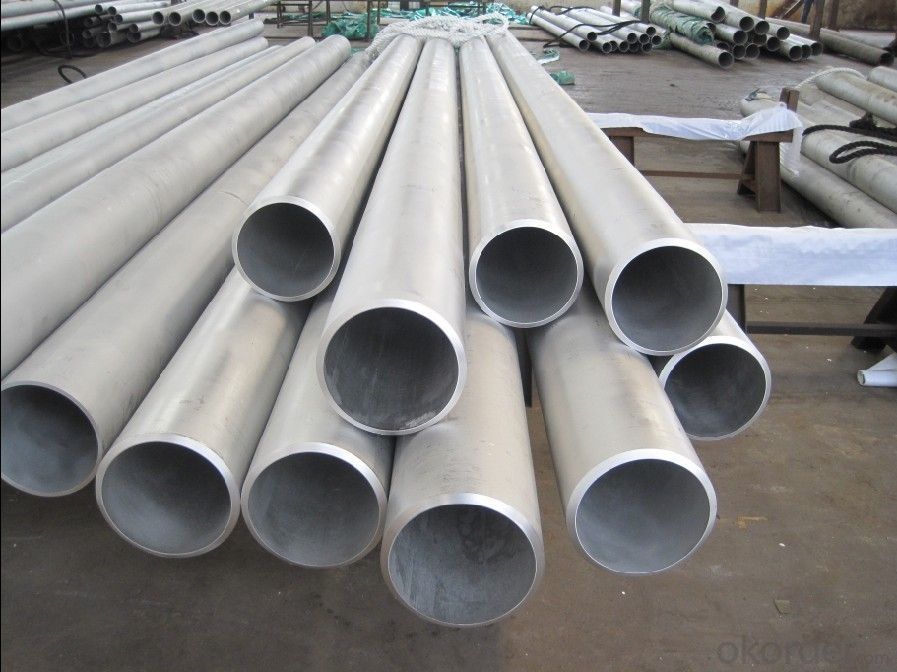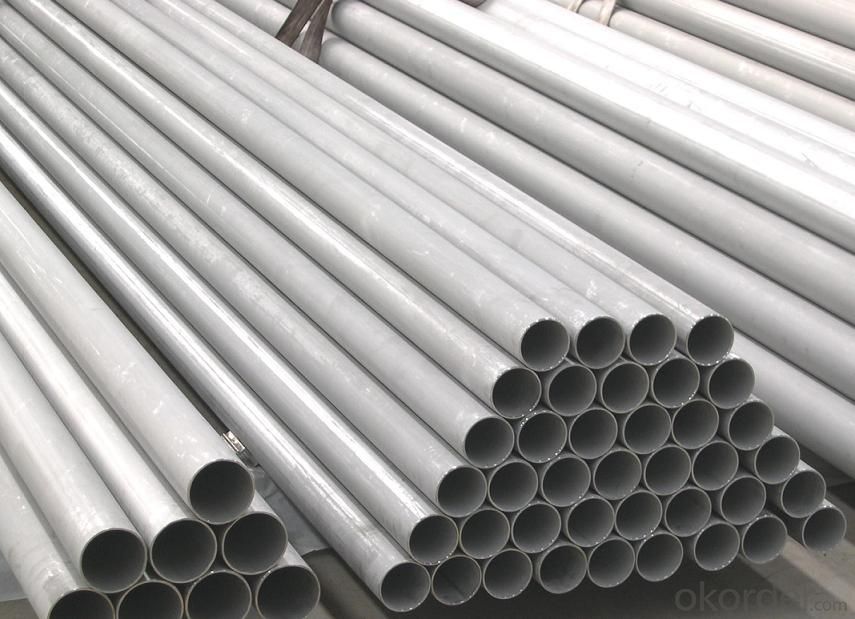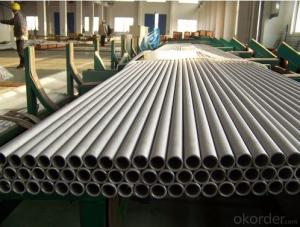Stainless Steel Welded Pipe duplex ASTM A790/ASTM A789 GB/T21832-2008
- Loading Port:
- Ningbo
- Payment Terms:
- TT OR LC
- Min Order Qty:
- 25 m.t.
- Supply Capability:
- 5000 m.t./month
OKorder Service Pledge
OKorder Financial Service
You Might Also Like
1、Structure of Stainless Steel Welded Pipe duplex ASTM A790/ASTM A789 GB/T21832-2008 Description:
Stainless steel welded pipe is actually a cover term, covering a wide range of alloy and making them suitable for different attributes that are used in a very wide and large numbers of different industries. Stainless steel pipe is resistant to erosion, highly flexible, powerful, easy to use, and can be done in distinct approaches, which means that more and more stainless steel was used as a construction material for large-scale, high impact buildings. It can be molded, rolling, and it can create amazing shapes to make it perfect, It is used as experimental buildings, The use of steel pipe welding of large stainless steel covers other examples.
2、Main Features of the Stainless Steel Welded Pipe duplex ASTM A790/ASTM A789 GB/T21832-2008:
• High manufacturing accuracy
• High strength
• Small inertia resistance
• Strong heat dissipation ability
• Good visual effect
•Reasonable price
3、Stainless Steel Welded Pipe duplex ASTM A790/ASTM A789 GB/T21832-2008 Images:



4、Stainless Steel Welded Pipe duplex ASTM A790/ASTM A789 GB/T21832-2008 Specification:
composition of duplex stainless pipe(%)
| Steel grade | C≤ | Mn≤ | Si≤ | S≤ | P≤ | Cr | Ni | Mo | Cu≤ | N |
| S32750((SAF2507) 00Cr22Ni7Mo4N | 0.03 | 1.20 | 0.80 | 0.020 | 0.035 | 24.0/ 26.0 | 6.0/ 8.0 | 3.0/ 5.0 | 0.50 | 0.24/ 0.32 |
| S31803(SAF2205) 00Cr22Ni5Mo3N | 0.03 | 2.00 | 1.0 | 0.02 | 0.030 | 21.0/ 23.0 | 4.50/ 6.50 | 2.50/ 3.50 | 0.08/ 0.20 | |
| S31500(3RE60) 00Cr18Ni5Mo3Si2 | 0.03 | 1.2/ 2.00 | 1. 4/ 2.00 | 0.030 | 0.030 | 18.0/ 19.0 | 4.25/ 5.25 | 2.50/ 2.00 | 0.05/ 0.10 |
Mechanical Properties of duplex pipe:
| Steel Grade | Heat Treatment Temperature ℃ | Ab(MPa)≥ | As(MPa)≥ | ∮≥ | brinell | rockwell |
| S32750(SAF2507) 00Cr22Ni5Mo3N | 1025-1125 water | 800 | 550 | 15 | 310 | 32 |
| S31803(SAF2205) 00Cr22Ni5Mo3N | 1020-1100 | 620 | 450 | 25 | 290 | 30.5 |
| S31500(3RE60) 00Cr18Ni5Mo3Si2 | 980-1040 | 630 | 440 | 30 | 290 | 30.5 |
Details:
Outer Diameter | 6mm--159mm | |||||
Thickness | 0.3mm - 3.0mm | |||||
Length | 6m or as customers' request | |||||
Surface | 180G, 320G, 400G Satin / Hairline 400G, 500G, 600G or 800G Mirror finish | |||||
Application | Decoration construction, upholstery, industry instrument | |||||
Test | Squash test, extended test, water pressure test, crystal rot test, heat treatment, NDT | |||||
5、FAQ of Stainless Steel Welded Pipe duplex ASTM A790/ASTM A789 GB/T21832-2008:
①How is the quality of your products?
Our products are manufactured strictly according to national and internaional standard, and we take a test on every pipe before delivered out. If you want see our quality certifications and all kinds of testing report, please just ask us for it.
Guaranteed: If products’ quality don’t accord to discription as we give or the promise before you place order, we promise 100% refund.
②How about price?
Yes, we are factory and be able to give you lowest price below market one, and we have a policy that “ for saving time and absolutely honest business attitude, we quote as lowest as possible for any customer, and discount can be given according to quantity”,if you like bargain and factory price is not low enough as you think, just don’t waste your time.Please trust the quotation we would give you, it is professional one.
③Why should you chose us?
Chose happens because of quality, then price, We can give you both.Additionally, we can also offer professional products inquiry, products knowledge train(for agents), smooth goods delivery, exellent customer solution proposals.Our service formula: good quality+good price+good service=customer’s trust
SGS test is available, customer inspection before shipping is welcome, third party inspection is no problem.
Any question, pls feel free to contact us !
- Q:How do you prevent galvanic corrosion in stainless steel pipes?
- To prevent galvanic corrosion in stainless steel pipes, there are several measures that can be taken: 1. Use compatible materials: It is crucial to ensure that the materials used in the vicinity of stainless steel pipes are compatible to prevent galvanic corrosion. Avoid using dissimilar metals such as carbon steel, copper, or aluminum in direct contact with the stainless steel pipes. 2. Insulate dissimilar metals: If it is necessary to have dissimilar metals in close proximity to stainless steel pipes, electrical insulation can be employed. By isolating the metals electrically, the flow of electric current and subsequent galvanic corrosion can be minimized. 3. Apply protective coatings: Applying protective coatings, such as paint or epoxy, to the external surface of stainless steel pipes can act as a barrier against galvanic corrosion. These coatings prevent direct contact between the stainless steel and other metals that may cause galvanic reactions. 4. Use dielectric unions: When connecting stainless steel pipes to dissimilar metals, dielectric unions can be used to separate the metals and prevent galvanic corrosion. These unions incorporate insulating materials like plastic or rubber to prevent direct contact between the metals. 5. Implement cathodic protection: Cathodic protection is an effective method to prevent galvanic corrosion in stainless steel pipes. By introducing a sacrificial anode, such as zinc or magnesium, to the system, the anode corrodes instead of the stainless steel. This sacrificial anode can be periodically replaced to ensure continuous protection. 6. Install corrosion-resistant alloys: If the application allows, using corrosion-resistant alloys, such as duplex stainless steel or titanium, can provide enhanced protection against galvanic corrosion. These alloys have better resistance to galvanic reactions and are less prone to corrosion in various environments. Overall, a combination of these preventive measures can significantly reduce the risk of galvanic corrosion in stainless steel pipes, ensuring their longevity and performance. It is important to evaluate the specific application and environment to determine the most suitable preventive measures to be implemented.
- Q:Can stainless steel pipes be coated with fusion bonded epoxy?
- Yes, stainless steel pipes can be coated with fusion bonded epoxy. This coating provides excellent corrosion resistance and improves the durability of the stainless steel pipes.
- Q:How do stainless steel pipes compare to PEX pipes?
- Stainless steel pipes and PEX pipes have different characteristics and applications, which make them suitable for different plumbing systems. Stainless steel pipes are known for their durability and strength. They are highly resistant to corrosion, which makes them ideal for use in water supply systems, especially in areas with aggressive water conditions. Stainless steel pipes can withstand high pressure and temperature, making them suitable for both residential and commercial applications. They are also fire-resistant, which adds to their safety profile. Additionally, stainless steel pipes have a long lifespan and require minimal maintenance, making them a cost-effective option in the long run. On the other hand, PEX pipes are made of cross-linked polyethylene, which offers flexibility and ease of installation. PEX pipes are highly resistant to freezing and bursting, making them suitable for cold-climate regions. They have the ability to expand and contract, which reduces the risk of leaks or bursts due to temperature changes. PEX pipes are also corrosion-resistant, eliminating the need for expensive and time-consuming maintenance. Additionally, PEX pipes are quieter compared to metal pipes, as they dampen noise and vibration. When choosing between stainless steel pipes and PEX pipes, it is essential to consider factors such as the specific plumbing requirements, budget, and local building codes. While stainless steel pipes excel in durability and strength, PEX pipes offer flexibility and ease of installation. Ultimately, the choice between the two will depend on the specific needs of the plumbing system and the preferences of the homeowner or plumbing professional.
- Q:How are stainless steel pipes different from carbon steel pipes?
- Stainless steel pipes and carbon steel pipes exhibit various dissimilarities encompassing their composition, corrosion resistance, and cost. To begin with, the composition of stainless steel pipes encompasses a notable amount of chromium, which imparts them with their distinctive corrosion resistance. Conversely, carbon steel pipes primarily consist of iron and carbon, devoid of any significant alloying elements. This divergence in composition endows stainless steel pipes with enhanced resistance against corrosion, oxidation, and the formation of rust when exposed to diverse environmental conditions or fluids. Additionally, stainless steel pipes possess exceptional strength and durability attributed to their alloying elements, such as nickel and molybdenum, which augment their mechanical properties. In contrast, carbon steel pipes, while sturdy, do not possess the same level of strength and durability as stainless steel pipes. Furthermore, stainless steel pipes exhibit high resistance to heat, rendering them suitable for applications involving elevated temperatures or extreme heat conditions. On the other hand, carbon steel pipes, albeit having satisfactory heat resistance, may not be as effective as stainless steel pipes in such applications. Lastly, the cost aspect plays a notable role in distinguishing stainless steel pipes from carbon steel pipes. Generally, stainless steel pipes are more costly than carbon steel pipes due to the elevated production expenses associated with their alloying elements and corrosion-resistant properties. In summary, stainless steel pipes diverge from carbon steel pipes in terms of their composition, corrosion resistance, strength, heat resistance, and cost. Stainless steel pipes offer superior corrosion resistance, heightened strength, and improved heat resistance, rendering them ideal for applications in corrosive environments or high-temperature conditions. However, they come at a higher cost compared to carbon steel pipes, which continue to be widely used in various industries due to their affordability and moderate mechanical properties.
- Q:Are stainless steel pipes suitable for oil and gas applications?
- Yes, stainless steel pipes are suitable for oil and gas applications. They have excellent corrosion resistance, high strength, and can withstand high temperatures and pressures commonly found in oil and gas operations. Additionally, stainless steel pipes are easily maintainable and have a long lifespan, making them a reliable choice for such applications.
- Q:What are the different types of stainless steel pipe bends?
- There are several different types of stainless steel pipe bends, including 45-degree, 90-degree, and 180-degree bends. Additionally, there are short radius and long radius bends, as well as U-bends and J-bends. These variations allow for flexibility in designing and connecting stainless steel piping systems to fit specific needs and spatial constraints.
- Q:How do you prevent noise transmission in stainless steel pipes?
- To prevent noise transmission in stainless steel pipes, various measures can be taken. One effective method is to use acoustic insulation materials, such as foam or rubber, to wrap around the pipes. This helps absorb and dampen the sound waves, reducing noise transmission. Additionally, installing vibration isolators or flexible pipe connectors at connecting points can minimize the transfer of vibrations and noise. Properly securing the pipes and ensuring they are properly supported can also help prevent noise transmission by reducing any rattling or vibrations.
- Q:How do stainless steel pipes compare to PVC pipes?
- Stainless steel pipes are generally more durable, have higher heat resistance, and are better suited for high-pressure applications compared to PVC pipes. While PVC pipes are lightweight, cost-effective, and easier to install, they are prone to cracking, chemical reactions, and may not be suitable for certain environments. Therefore, the choice between stainless steel and PVC pipes depends on the specific needs of the application.
- Q:Can stainless steel pipes be used for sewage applications?
- Yes, stainless steel pipes can be used for sewage applications. Stainless steel offers good corrosion resistance and durability, making it suitable for handling the harsh and corrosive nature of sewage. Additionally, stainless steel pipes have smooth surfaces, preventing the accumulation of debris and facilitating the flow of sewage.
- Q:Can stainless steel pipes be used for both high and low-pressure applications?
- Stainless steel pipes possess the ability to serve in high and low-pressure scenarios. Stainless steel's reputation for its robustness, endurance, and corrosion resistance renders it apt for diverse pressure circumstances. It can endure high pressures unflinchingly, without any distortion or breakage, hence proving to be an optimal choice for high-pressure purposes such as oil and gas pipelines, chemical processing plants, and hydraulic systems. Furthermore, it can be employed for low-pressure applications such as plumbing systems and water supply lines. The adaptable nature of stainless steel pipes enables their usage across an extensive array of pressure conditions, which contributes to their popularity in numerous industries.
1. Manufacturer Overview |
|
|---|---|
| Location | |
| Year Established | |
| Annual Output Value | |
| Main Markets | |
| Company Certifications | |
2. Manufacturer Certificates |
|
|---|---|
| a) Certification Name | |
| Range | |
| Reference | |
| Validity Period | |
3. Manufacturer Capability |
|
|---|---|
| a)Trade Capacity | |
| Nearest Port | |
| Export Percentage | |
| No.of Employees in Trade Department | |
| Language Spoken: | |
| b)Factory Information | |
| Factory Size: | |
| No. of Production Lines | |
| Contract Manufacturing | |
| Product Price Range | |
Send your message to us
Stainless Steel Welded Pipe duplex ASTM A790/ASTM A789 GB/T21832-2008
- Loading Port:
- Ningbo
- Payment Terms:
- TT OR LC
- Min Order Qty:
- 25 m.t.
- Supply Capability:
- 5000 m.t./month
OKorder Service Pledge
OKorder Financial Service
Similar products
New products
Hot products
Hot Searches
Related keywords






























